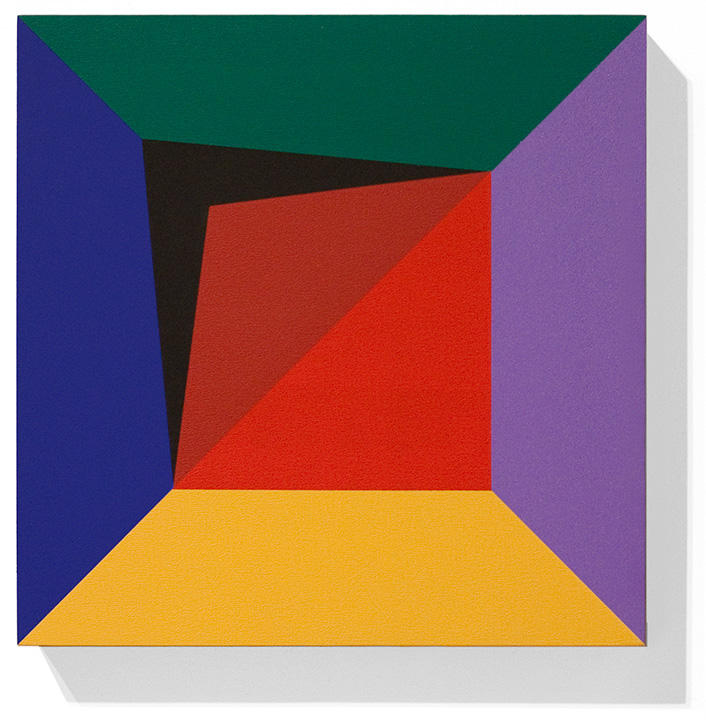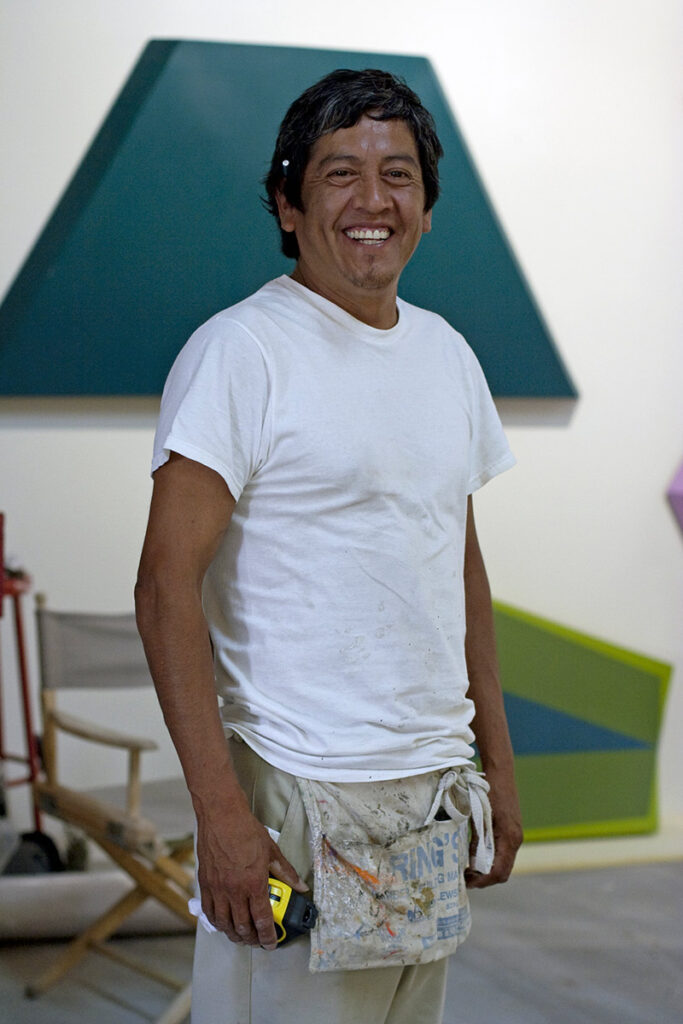 A young man named Jeff came here a decade or so ago to pick up some art, and let it be known he needed some work. It was good timing, because I needed a studio assistant; so I said I’d give him a trial. He had been working odd jobs here and there, mostly house painting and art-moving. He and his buddy came back some days later to do a few more things for me. As soon as we all got to working, I saw Jeff was smart and steady, and I realized I had a lot of things I wanted him to do. He had been to art school – the IAIA in Santa Fe. Jeff is strikingly handsome, and has the most beautiful ears.
A young man named Jeff came here a decade or so ago to pick up some art, and let it be known he needed some work. It was good timing, because I needed a studio assistant; so I said I’d give him a trial. He had been working odd jobs here and there, mostly house painting and art-moving. He and his buddy came back some days later to do a few more things for me. As soon as we all got to working, I saw Jeff was smart and steady, and I realized I had a lot of things I wanted him to do. He had been to art school – the IAIA in Santa Fe. Jeff is strikingly handsome, and has the most beautiful ears.
The reason I needed a studio assistant was that I had just gotten a new gallery, and needed help in creating a show. Because I was not in the greatest health at the time, I wasn’t sure if I could mount yet another exhibition. Happily, Jeff agreed to work with me for two or three days per week.
In getting to know each other, I found out Jeff was a tribal member of both the well-known Acoma Pueblo (Sky City) and the Diné (the Navajo Nation). I learned that Acoma Pueblo is different from the other northern New Mexico pueblos because the village is perched on top of a very high mesa, rather than next to the Rio Grande. Jeff was living near Santa Fe when I met him, but he was willing to commute all the way to my studio, a nearly 100-mile journey one-way. Without knowing the extent of his excellent skills as a carpenter, a painter, and a man, I paid him at the time what we both felt was a fair wage. I came to value his skills, his workmanship, and his work ethic. More than that, Jeff’s laid-back, undemanding, calm and quiet nature made him very special – along with his willingness to often work far into the night with me in order to get the next thing done, keeping the creative flow going in the studio. Over the next several months, our friendship developed, and we were able to have free-wheeling conversations about art, life, and the universe. When the topic turned to sad, bad, or frightening things like climate change, death, war, or anything worrisome, he would say, with the most tranquil acceptance, “It’s just the cycle of life.” His matter-of-fact, peaceful demeanor was very wise, and it helped me a lot.
In my youth growing up in Cheyenne, Wyoming, I did not have opportunities to get close to many native Americans, but I did sometimes cross paths with tribal members from the nearby Wyoming and South Dakota reservations as they traveled through Cheyenne. Jeff was not one to complain about it, but I sensed in him the sorrow of his people, no doubt the result of centuries of racial discrimination directed towards all First Americans, the survivors who still carry the dark and heavy shadow of systematic genocide.

In the next year or so, using our combined carpentry skills, together Jeff and I figured out how to create and build precision works of art using expanded poly-vinyl chloride plastic (PVC), plastic cement or glue, gesso, and Golden acrylic paints. Once we perfected the format, he would be in the saw-room for hours, sawing and sanding, priming sheets of PVC into a hard and smooth surface, mitering corners and cutting precise angles so that everything fit together beautifully. Without much direction, Jeff served up near-perfect objects on which I could paint. By doing what he did, he laid the groundwork which freed and enabled me to think about design, composition, color: the painting. Towards the end of that year, with Jeff’s help, I was able to mount a successful exhibition of several dozen 20-inch square paintings and several complicated, beveled, shaped paintings.
I soon found out, because we were working so closely together – collaborating on mixing colors, building and preparing the PVC substrates, measuring and gluing, making creative and procedural decisions – that he was a much better carpenter and paint color-matcher than I was. When he wasn’t helping me make paintings, he was organizing, sweeping, picking up, cleaning, washing brushes, making me dinner, planting his grandfather’s ancient Acoma corn in our garden, putting up our Christmas lights, moving things.
As far as my work goes, my year with Jeff was as fulfilling and creative a year of art-making as I’ve ever had. But the labor-intensive work and the relatively costly materials, coupled with the gallery giving extra discounts to favored collectors, left me with little profit from sales after all the work we had done. I computed our costs of making the paintings, and realized it cost more to make them than I could get paid for them. I asked my dealer if they would help figure out some way, such as selling an old painting, or finding a collector/benefactor who might invest in something, but I was met with crickets. After the show, the dealer did say that if I had made smaller pieces, there may have been a chance some sales could be made faster, but there was no longer an avenue for sales at the time. Therefore, it was with deep regret that I had to admit I couldn’t keep Jeff working.
 Before he left, he built for me twelve small PVC blocks, putting into them all his love and craftsmanship and everything we had learned together. He finished up the twelve blocks late one night; we exchanged gifts, said good-night, and that was the last we spoke. I miss him a lot.
Before he left, he built for me twelve small PVC blocks, putting into them all his love and craftsmanship and everything we had learned together. He finished up the twelve blocks late one night; we exchanged gifts, said good-night, and that was the last we spoke. I miss him a lot.
I painted only a couple of those twelve small Jeff-blocks over the next ten years. But I felt and still feel that they are special treasures, more meaningful to me than just a bunch of potential small paintings that could be quickly sold.
Last spring, 203 Fine Art in Taos engaged me with an offer to manage, promote, and sell my legacy works. Being 84 years old, it felt like the right time. Nobody else in the art world was stepping up to help me with the 1,000 or more artworks I still have after fifty years of painting! Eric at 203 Fine Art thought these new, small gems (that is, the few I have actually finished painting but have never shown) would be a good complement to the larger legacy paintings we are about to exhibit. (Ronald Davis: Seven Decades, September 25th, 5-7, 203 Fine Art, Taos, NM)
I like to work in series, and felt it would be expeditious to come full-circle and finish the other eight or nine blocks I have sitting there ready to go, ever since Jeff left. After my heart attack seven years ago, I haven’t painted much. It was harder to start working on those blocks than I imagined it would be. Nevertheless, for the first time in many years, I have launched a new series. I have kept these special blocks at the front of my studio, studying them, trying to pick a color for each facet of each block. I have found it pretty slow going. I had one of the half-finished blocks sitting on a stool next to some new circular paintings I’ve been working on. The stool didn’t make a very good stand, so I figured out a different, better sculpture stand using other materials. I discovered the blocks could either be hung on a wall, or displayed as a small sculpture. They are simultaneously paintings and sculptures, and they look good either way.
My wife was in the studio with me recently, and I asked her to take a photo of one of the blocks I had on the wall, along with a new small oval painting and the block on the sculpture stand. She did so, and it made a wonderful picture (see above). It occurred to me that the threesome was like a shrine. A shrine to what? A shrine that embodies but also transcends my collaborative relationship with my much-missed assistant Jeff. I made the dual association that it is a shrine to the struggles I have been having, not just with painting these blocks, but also to the last few years in my old age, especially during the pandemic; and to the struggles of everyone who is trying to cope with this Covid19 virus. Viewing the threesome made me think of a phrase that many of us now use on a daily basis when leave-taking: “Be Safe!” Thus, the threesome became the Be Safe! Shrine.
The title of the upcoming exhibition at 203 Fine Art is Seven Decades: Works from the 1960s to the 2020s. The two blocks in the Shrine configuration, Hexette Wedge II and Red Top Quad I, and the new oval painting, Orange and Maroon Oval, represent the journey my assistant and I took together, with our hopes and our fears, into the 2020s.
Epilogue: It is with some sadness I realize that 2010 was the last time I was able to speak with Jeff. I’ve lost track of him now. (Jeff, we hope you are well and safe. If you see this, please email me!) Somehow, we gave each other all we had to give. So it is somehow right, the fact I haven’t talked to him. I believe he would say it’s the natural synchronization of the cosmos. “It’s just the cycle of life.”
Hexette Wedge II
2021, 10 ½ x 9 ½ inches
Acrylic on Expanded PVC
Orange Maroon Oval
2021, 20 x 16 inches
Acrylic on shaped canvas
Red Top Quad I
2009, repainted in 2021
7 ⅛ x 8 ½ x 3 inches
Acrylic on Expanded PVC
Be Safe! Shrine
All three works:
Hexette Wedge II, Orange Maroon Oval, and Red Top Quad I
with painted birch plywood plane and sculpture stand
Dark Red Lean II
2010, 20 x 20 x 3 inches
Acrylic on Expanded PVC
PTN as Obj Group – Squares
